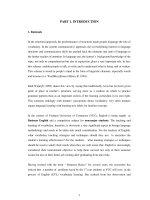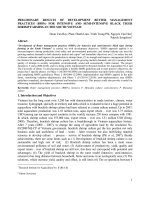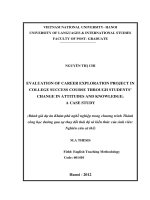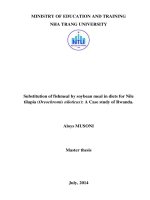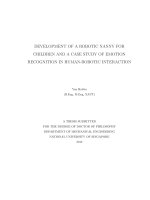Development of a robotic nanny for children and a case study of emotion recognition in human robotic interaction
Bạn đang xem bản rút gọn của tài liệu. Xem và tải ngay bản đầy đủ của tài liệu tại đây (2.12 MB, 172 trang )
DEVELOPMENT OF A ROBOTIC NANNY FOR
CHILDREN AND A CASE STUDY OF EMOTION
RECOGNITION IN HUMAN-ROBOTIC INTERACTION
Yan Haibin
(B.Eng, M.Eng, XAUT)
A THESIS SUBMITTED
FOR THE DEGREE OF DOCTOR OF PHILOSOPHY
DEPARTMENT OF MECHANICAL ENGINEERING
NATIONAL UNIVERSITY OF SINGAPORE
2012ii
Acknowledgements
I would like to express my deep and sincere gratitude to my supervisors, Prof.
Marcelo H Ang Jr and Prof. Poo Aun-Neow. Their enthusiastic supervision and
invaluable guidance have been essential for the results presented here. I am very
grateful that they have spent much time with me to discuss different research
problems. Their knowledge, suggestions, and discussions help me to become a
more capable researcher. Their encouragement also helps me to overcome the
difficulties encountered in my research.
I would also like to express my thanks to other members in our group, Dai Dongjiao
Tiffany, Dev Chandan Behera, Cheng Chin Yong, Wang Niyou, Shen Ziho ng,
Kwek Choon Sen Alan, and Lim Hewei, who were involved to help the development
of our robot Dorothy Robo tubby.
In addition, I would like to thank Mr. Wong Hong Yee Alvin from A*STAR, I
2
R
and Prof. John-John Cabibihan from National University of Singapore for their
valuable suggestions and comments that have helped us to design a pilot study to
evaluate our developed robot.
Next, I would like to thank Prof. Marcelo H Ang Jr, Prof. John- John Cabibihan,
Mrs. Tuo Ying chong, Mrs. Zhao Meijun, and their family members who were
iii
involved in our pilot studies to evaluate the developed ro bot.
Lastly, my sincere thanks to Department of Mechanical Engineering, National
University of Singapore, Singapore, for providing the full research scholarship to
me to support my Ph.D study.
iv
Table of Contents
Declaration i
Acknowledgements ii
Table of Contents iv
Summary viii
List of Tables xi
List of Figures xiii
1 Introduction 1
1.1 Development of A Robotic Nanny for Children . . . . . . . . . . . 3
1.2 Emotion Recognition in the Robotic Nanny . . . . . . . . . . . . 9
1.2.1 Facial Expression-Based Emotion Recognition . . . . . . . 11
1.3 Summary . . . . . . . . . . . . . . . . . . . . . . . . . . . . . . . 14
2 Literature Review 16
2.1 Design A Social Robot for Children . . . . . . . . . . . . . . . . . 16
2.1.1 Design Approaches and Issues . . . . . . . . . . . . . . . . 17
2.1.2 Representative Social Robotics for A Child . . . . . . . . . 21
v
2.1.3 Discussion . . . . . . . . . . . . . . . . . . . . . . . . . . . 25
2.2 Facial Expression-Based Emotion Recognition . . . . . . . . . . . 26
2.2.1 Appearance-Based Facial Expression Recognition . . . . . 28
2.2.2 Facial Expression Recognition in Social Robotics . . . . . . 34
2.2.3 Discussion . . . . . . . . . . . . . . . . . . . . . . . . . . . 36
3 Design and Development of A Robotic Nanny 39
3.1 Introduction . . . . . . . . . . . . . . . . . . . . . . . . . . . . . . 39
3.2 Overview of Dorothy Robot ubby System . . . . . . . . . . . . . . 42
3.2.1 System Configuration . . . . . . . . . . . . . . . . . . . . . 42
3.2.2 Dorothy Robot ubby Introduction . . . . . . . . . . . . . . 44
3.3 Dorothy Robot ubby User Interface and Remote User Interface . . 48
3.3.1 Dorothy Robot ubby User Interface . . . . . . . . . . . . . 48
3.3.2 Remote User Interface . . . . . . . . . . . . . . . . . . . . 50
3.4 Dorothy Robot ubby f unction Description . . . . . . . . . . . . . . 52
3.4.1 Face Tracking . . . . . . . . . . . . . . . . . . . . . . . . . 53
3.4.2 Emotion Recognition . . . . . . . . . . . . . . . . . . . . . 54
3.4.3 Telling Stories . . . . . . . . . . . . . . . . . . . . . . . . . 57
3.4.4 Playing Games . . . . . . . . . . . . . . . . . . . . . . . . 60
3.4.5 Playing Music Videos . . . . . . . . . . . . . . . . . . . . . 61
3.4.6 Chatting with A Child . . . . . . . . . . . . . . . . . . . . 63
3.4.7 Video Calling . . . . . . . . . . . . . . . . . . . . . . . . . 65
3.5 Summary . . . . . . . . . . . . . . . . . . . . . . . . . . . . . . . 66
4 Misalignment-Robust Facial Expression Recognition 68
4.1 Introduction . . . . . . . . . . . . . . . . . . . . . . . . . . . . . . 68
vi
4.2 Empirical Study of Appearance-Based Facial Expression Recogni-
tion with Spatia l Misalignment s . . . . . . . . . . . . . . . . . . . 71
4.2.1 Data Sets . . . . . . . . . . . . . . . . . . . . . . . . . . . 71
4.2.2 Results . . . . . . . . . . . . . . . . . . . . . . . . . . . . . 72
4.3 Proposed Approach . . . . . . . . . . . . . . . . . . . . . . . . . . 75
4.3.1 LDA . . . . . . . . . . . . . . . . . . . . . . . . . . . . . . 75
4.3.2 BLDA . . . . . . . . . . . . . . . . . . . . . . . . . . . . . 77
4.3.3 IMED-BLDA . . . . . . . . . . . . . . . . . . . . . . . . . 79
4.4 Exp erimental Results . . . . . . . . . . . . . . . . . . . . . . . . . 83
4.5 Summary . . . . . . . . . . . . . . . . . . . . . . . . . . . . . . . 87
5 Cross-Dataset Facial Expression Recognition 89
5.1 Introduction . . . . . . . . . . . . . . . . . . . . . . . . . . . . . . 89
5.2 Related Work . . . . . . . . . . . . . . . . . . . . . . . . . . . . . 91
5.2.1 Subspace Learning . . . . . . . . . . . . . . . . . . . . . . 91
5.2.2 Transfer Learning . . . . . . . . . . . . . . . . . . . . . . . 92
5.3 Proposed Methods . . . . . . . . . . . . . . . . . . . . . . . . . . 93
5.3.1 Basic Idea . . . . . . . . . . . . . . . . . . . . . . . . . . . 93
5.3.2 TPCA . . . . . . . . . . . . . . . . . . . . . . . . . . . . . 95
5.3.3 TLDA . . . . . . . . . . . . . . . . . . . . . . . . . . . . . 96
5.3.4 TLPP . . . . . . . . . . . . . . . . . . . . . . . . . . . . . 96
5.3.5 TONPP . . . . . . . . . . . . . . . . . . . . . . . . . . . . 97
5.4 Exp erimental Results . . . . . . . . . . . . . . . . . . . . . . . . . 97
5.4.1 Data Preparation . . . . . . . . . . . . . . . . . . . . . . . 97
5.4.2 Results . . . . . . . . . . . . . . . . . . . . . . . . . . . . . 100
5.5 Summary . . . . . . . . . . . . . . . . . . . . . . . . . . . . . . . 104
vii
6 Dorothy Rob otubby Evaluation in Real Pilot Studies 108
6.1 Introduction . . . . . . . . . . . . . . . . . . . . . . . . . . . . . . 108
6.2 Exp erimental Settings and Procedures . . . . . . . . . . . . . . . 110
6.3 Evaluation Methods . . . . . . . . . . . . . . . . . . . . . . . . . 112
6.4 Results and Discussion . . . . . . . . . . . . . . . . . . . . . . . . 114
6.4.1 Results from Questionnaire Analysis . . . . . . . . . . . . 114
6.4.2 Results from Behavior Analysis . . . . . . . . . . . . . . . 121
6.4.3 Results from Case Study . . . . . . . . . . . . . . . . . . . 126
6.4.4 Discussion . . . . . . . . . . . . . . . . . . . . . . . . . . . 133
6.5 Summary . . . . . . . . . . . . . . . . . . . . . . . . . . . . . . . 134
7 Conclusions and Future Work 136
7.1 Conclusions . . . . . . . . . . . . . . . . . . . . . . . . . . . . . . 136
7.2 Future work . . . . . . . . . . . . . . . . . . . . . . . . . . . . . . 139
Bibliography 141
Appendix 151
viii
Summary
With the rapid development of current society, parents become more busy and
cannot always stay with their children. Hence, a robotic nanny which can care
for and play with children is desirable. A robotic nanny is a class of social robots
acting as a child’s caregiver and aims to extend the length of parents or caregiver
absences by providing entertainment to the child, tutoring the child, keeping the
child from physical harm, and ideally, building a companionship with the child.
While many social robo t ics have been developed for children in entertainmen-
t, healthcare, and domestic areas, and some promising performance have b een
demonstrated in their target environments, they cannot be directly applied as
a robotic nanny, or cannot satisfy our specific design objectives. Therefore, we
develop our own robo t ic nanny by taking the existing robots as references.
Considering our specific design objectives, we design a robotic nanny na med
Dorothy Robotubby with a caricatured appearance, which consists of a head, a
neck, a body, two arms, two hands, and a to uch screen in its belly. Then, we devel-
op two main user interfaces which are local control-based and remote control-based
for the child and parents, respectively. Local control-based int erface is developed
ix
for a child to control the robot directly to execute some tasks such as telling a s-
tory, playing music and games, chatting, and video calling. Remote control-ba sed
interface is designed for parents to control the robot r emotely to execute several
commands like demonstrating facial expressions and gestures when communicat-
ing with a child via “video-chat” (like Skype). Since emotion recognition can make
important contributions towards achieving a believable and acceptable robo t and
has become a necessary and significant function in social robo tics for a child, we
also study facial expression-based emotion recognition by addressing two problems
which are impor tant to drive facial expression recognition into real-world applica-
tions: misalignment- robust facial expression recognition and cross-dataset f acial
expression recognition. For misalignment-ro bust facial expression recognition, we
first propose a biased discriminative learning method by imposing large penalties
on interclass samples with small differences and small penalties on those samples
with large differences simulta neously such that more discriminative features can
be extracted for recognitio n. Then, we learn a robust feature subspace by using
the IMage Euclidean Distance (IMED) rather than the widely used Euclidean dis-
tance such that the subspace sought is more discriminative and robust to spatial
misalignments. For cross-dataset facial expression recognition, we propose a new
transfer subspace learning approach to learn a feature space which transfers the
knowledge gained from the training set to the target ( t esting) data to improve
the recognition performa nce under cross-data set scenarios. Following this idea,
we formulate four new transfer subspace learning methods, i.e., transfer prin-
cipal component analysis (TPCA), transfer linear discriminant analysis (TLDA),
x
transfer locality preserving projections (TLPP), and transfer orthogonal neighbor-
hood preserving projections (TONPP). Lastly, we design a pilot study to evaluate
whether the children like the appearance and functions of Dorothy Robotubby and
collect the parents’ opinions to the remote user interface designs. To analyze the
performance of Robotubby and the interaction between the child and the robot,
we employ questionnaires and videotapes. Correspondingly, evaluation results are
obtained by questionnaire analysis, behavior analysis, and case studies.
In summary, for misalignment-robust and cross-dataset facial expression recogni-
tions, experimental results have demonstrated the efficacy of our proposed meth-
ods. While for t he design of our robot Dorothy Robotubby, evaluation results from
pilot studies have shown that while there is some room to improve our robotic
nanny, most children and parents show great interest in our robot and provide
comparatively positive evaluation. More important, several valuable and helpful
suggestions are obtained f rom the result analysis phase.
xi
List of Ta bles
2.1 The methods for fa cial expression analysis described in this subsec-
tion. . . . . . . . . . . . . . . . . . . . . . . . . . . . . . . . . . . 33
2.2 Generalization performance to independent databases. . . . . . . 33
2.3 Properties of an ideal automatic facial expression recognition system. 35
3.1 Input and Output Devices. . . . . . . . . . . . . . . . . . . . . . . 45
3.2 The information of a Samsung Slate PC. . . . . . . . . . . . . . . 46
3.3 The used servo motors in Robotubby. . . . . . . . . . . . . . . . . 47
4.1 Recognition performance comparison on the Cohn-Kanade database. 8 4
4.2 Recognition performance comparison on the JAFFE database. . . 84
5.1 Objective functions and constraints of four popular subspace learn-
ing methods. . . . . . . . . . . . . . . . . . . . . . . . . . . . . . . 92
5.2 Confusion matrix of seven-class expression recognition obt ained by
PCA under the F2C setting. . . . . . . . . . . . . . . . . . . . . . 104
xii
5.3 Confusion matrix of seven-class expression recognition obt ained by
LDA under the F2C setting. . . . . . . . . . . . . . . . . . . . . . 105
5.4 Confusion matrix of seven-class expression recognition obt ained by
LPP under the F2C setting. . . . . . . . . . . . . . . . . . . . . . 105
5.5 Confusion matrix of seven-class expression recognition obt ained by
ONPP under the F2C setting. . . . . . . . . . . . . . . . . . . . . 105
5.6 Confusion matrix of seven-class expression recognition obt ained by
TPCA under the F2C setting. . . . . . . . . . . . . . . . . . . . . 106
5.7 Confusion matrix of seven-class expression recognition obt ained by
TLDA under the F2C setting. . . . . . . . . . . . . . . . . . . . . 106
5.8 Confusion matrix of seven-class expression recognition obt ained by
TLPP under the F2C setting. . . . . . . . . . . . . . . . . . . . . 106
5.9 Confusion matrix of seven-class expression recognition obt ained by
TONPP under the F2C setting. . . . . . . . . . . . . . . . . . . . 107
6.1 Personal information of the children involved in the survey. . . . . 110
6.2 The questions used in the questionnaire for the child. . . . . . . . 113
6.3 The questions used in the questionnaire for the parent. . . . . . . 113
xiii
List of Figures
2.1 The uncanny valley [18]. . . . . . . . . . . . . . . . . . . . . . . . 20
2.2 Several representative social robotics for a child. From left to right
and top to down, they a r e AIBO [11], Probo [13], PaPeRo [15], SDR
[11], RUBI [42], iRobiQ [44], Paro [45], Huggable [24], Keepon [47],
iCat [48], EngKey [49], and Iromec [50], respectively. . . . . . . . 22
2.3 Emotion-specified facial expressions which are anger, disgust, fear,
happy, sad, surprise, and neutral expressions, respectively [56]. . . 29
3.1 System configuration . . . . . . . . . . . . . . . . . . . . . . . . . 42
3.2 Schematics of the whole system . . . . . . . . . . . . . . . . . . . 43
3.3 Main components of Dor othy Robotubby . . . . . . . . . . . . . . 45
3.4 Several examples of different facial expressions of Robotubby . . . 47
3.5 User interface of Robotubby . . . . . . . . . . . . . . . . . . . . . 48
3.6 Remote user interface . . . . . . . . . . . . . . . . . . . . . . . . . 50
3.7 Emotion recognition interface. . . . . . . . . . . . . . . . . . . . . 55
xiv
3.8 Template training interface for emotion recognition. . . . . . . . . 57
3.9 The sub-interface of storytelling. . . . . . . . . . . . . . . . . . . . 58
3.10 Several samples of different facial expressions and gestures during
telling a story. . . . . . . . . . . . . . . . . . . . . . . . . . . . . . 58
3.11 The flowchart of storytelling function. . . . . . . . . . . . . . . . . 59
3.12 The sub-interface of playing games. . . . . . . . . . . . . . . . . . 60
3.13 Several samples of different gestures during the game playing. . . 60
3.14 Limit Switch and its locations. . . . . . . . . . . . . . . . . . . . . 61
3.15 The flowchart of playing game function. . . . . . . . . . . . . . . . 62
3.16 The sub-interface of playing music videos. . . . . . . . . . . . . . 63
3.17 Several samples of different gestures during singing a song. . . . . 63
3.18 The flowchart of playing music video function. . . . . . . . . . . . 64
3.19 The sub-interface of chatting with a child. . . . . . . . . . . . . . 65
3.20 The sub-interface of video calling. . . . . . . . . . . . . . . . . . . 65
3.21 The blinking notification button for the incoming call. . . . . . . . 66
4.1 The flowchart of an automatic facial expression recognition system. 69
xv
4.2 Examples of the original, well-aligned, and misaligned images of
one subject from the (a) Cohn-Kanade and ( b) JAFFE databases.
From left to right are the facial images with anger, disgust, fear,
happy, neutra l, sad, and surprise expressions, respectively. . . . . 73
4.3 Recognition accuracy versus different amounts of spatia l misalign-
ments on the Cohn-Kanade database. . . . . . . . . . . . . . . . . 74
4.4 Recognition accuracy versus different amounts of spatia l misalign-
ments on the JAFFE database. . . . . . . . . . . . . . . . . . . . 74
4.5 The projections of the first three components of the original data
on the PCA feature space. . . . . . . . . . . . . . . . . . . . . . . 79
4.6 The projections of the first three components of the original data
on the LDA feature space. . . . . . . . . . . . . . . . . . . . . . . 80
4.7 The projections of the first three components of the original data
on the BLDA feature space. Note that here α is set to be 50 for
BLDA. For interpretatio n of color in this figure, please refer to t he
original enlarged color pdf file. . . . . . . . . . . . . . . . . . . . . 80
4.8 The ratio of the tra ce of the between-class scatter to the trace of the
within-class scatter by using the Euclidean and IMED distances on
the Cohn-Kanade database. It is easy to observe from this figure
that IMED is better than the Euclidean distance in characterizing
this ratio. Moreover, the larger amo unts of the misalignment, the
better performance obtained. . . . . . . . . . . . . . . . . . . . . . 83
xvi
4.9 Performa nce comparisons of PCA and IMED-PCA subspace meth-
ods learned by the Euclidean and IMED metric, respectively. . . . 85
4.10 Perfo r ma nce comparisons of LPP and IMED-LPP subspace meth-
ods learned by the Euclidean and IMED metric, respectively. . . . 86
4.11 Perfo r ma nce comparisons of ONPP and IMED-O NPP subspace
methods learned by the Euclidean and IMED metric, respective-
ly. . . . . . . . . . . . . . . . . . . . . . . . . . . . . . . . . . . . 86
4.12 The performance of IMED-BLDA versus different values of α. . . 87
5.1 Facial expression ima ges of one subject f r om the (a) JAFFE, (b)
Cohn-Kanade, and (c) Feedtum databases. From left to right are
the images with anger, disgust, fear, happy, sad, surprise and neu-
tral expressions, respectively. . . . . . . . . . . . . . . . . . . . . . 99
5.2 Recognition accuracy versus different featur e dimensions under the
J2C experimental setting. . . . . . . . . . . . . . . . . . . . . . . 101
5.3 Recognition accuracy versus different featur e dimensions under the
J2F experimental setting. . . . . . . . . . . . . . . . . . . . . . . 101
5.4 Recognition accuracy versus different featur e dimensions under the
C2J experimental setting. . . . . . . . . . . . . . . . . . . . . . . 102
5.5 Recognition accuracy versus different featur e dimensions under the
C2F experimental setting. . . . . . . . . . . . . . . . . . . . . . . 102
xvii
5.6 Recognition accuracy versus different featur e dimensions under the
F2J experimental setting. . . . . . . . . . . . . . . . . . . . . . . 103
5.7 Recognition accuracy versus different featur e dimensions under the
F2C experimental setting. . . . . . . . . . . . . . . . . . . . . . . 103
6.1 Two testing rooms of pilot study where (a) is testing room for the
child and (b) is t esting room for the pa r ent. . . . . . . . . . . . . 111
6.2 The statistical result of Question 1 in Table 6.2. . . . . . . . . . . 114
6.3 The statistical result of Question 2 in Table 6.2. . . . . . . . . . . 115
6.4 The statistical result of Question 3 in Table 6.2. . . . . . . . . . . 116
6.5 The statistical result of Question 4 in Table 6.2. . . . . . . . . . . 117
6.6 The statistical result of Question 5 in Table 6.2. . . . . . . . . . . 118
6.7 The statistical result of Question 6 in Table 6.2. . . . . . . . . . . 119
6.8 The statistical result of Question 1 in Table 6.3. . . . . . . . . . . 120
6.9 Two examples of the children’s gaze behavior. . . . . . . . . . . . 122
6.10 Two examples of the children’s smile behavior. . . . . . . . . . . . 123
6.11 Two examples of the children’s touching behavior. . . . . . . . . . 124
6.12 Several pictures for Case 1 . . . . . . . . . . . . . . . . . . . . . . . 127
6.13 Two examples of C5’s behavior for Case 2 where (a) is clapping
hands and (b) is smile. . . . . . . . . . . . . . . . . . . . . . . . . 129
xviii
6.14 Two scene examples of C7. . . . . . . . . . . . . . . . . . . . . . . 132
1
Chapter 1
Introduction
Social robo t ics, an importa nt branch of robotics, has recently attracted increasing
interest in many disciplines, such as computer vision, artificial intelligence, and
mechatronics, and ha s also emerged as an interdisciplinary undertaking. While
many social robots have been developed, a formal definition of social robot has
not been agreed on and different practitioners have defined it from different per-
spectives. For example, Breazeal et al. [1] explained that a social robot is a robot
which is able to communicate with humans in a personal way; Fong et al. [2]
defined social robots as being able to recognize each other and engage in social
interactio ns; Bart neck and Forlizzi [3] described a social robot as an auto nomous
or semi-autonomous robot that interacts with humans by following some social be-
haviors; Hegel et al. [4] defined that a social robot is a combination of a robot and
a social interface. In Wikipedia, a social robot [5] is specified to be an autonomous
robot that interacts and communicates with humans or other autonomous physi-
cal agents by following some social rules. While there are some differences among
2
these definitions, they have a common characteristic which is to interact with hu-
mans. While a great deal of challenges ar e encountered when social robots are
used in real-world applications, there are already some social robots being de-
veloped or commercially available t o assist our daily lives. They have been used
for testing, assisting, and interacting [2]. Depending on their application objects,
they can be utilized for the child, the elderly, and the adult.
Among these applications, we mainly focus on developing social robotics for the
child in this work. The developed social robotics can not only be used at home to
be a child’s companio n, nanny, for ent ertainment, but also in several public places
like schools, hospitals, and care houses to accomplish some assisting tasks. The
robotic companion and nanny can play with and care for the child at home during
the absence of busy working parents. Compared with televisions and videos,
the robot enables t o extend the length of parents’ absence. In addition, it can
keep the child safe fr om harm via its monito r ing function for a longer time [6].
In public places like hospitals, kindergartens, and care houses, the robots can
implement pre-specified tasks to assist nurses and teachers, and can be employed
for animal-assisted therapy (AAT) and animal-assisted activities (AAA) instead
of real animals [2]. This can partly reduce working strength of the staff, activate
learning interest of the child, comfort the child in hospitalization, and provide
better therapy to the child with disabilities such as autism [7].
In this study, we aim to develop a robot ic nanny to be used at home to take care
of a child, play with a child, and activate a child’s interest to learn new knowledge.
With the rapid development of current society and increasing living pressure, the
parents may be very busy and cannot always stay with their children. Under
3
such situation, a robotic nanny can care for and play with the children during
parents’ absence. This can release the pressure of parents to a certain extent.
Furthermore, due to the concentration of high technologies in the robot , it may
activate the child’s interest to play with the robot and learn new knowledge during
their interaction. The robo t ic nanny also serves as a two-way communication
device with video and physical interaction since the parent can remotely move the
limbs of the robo tic nanny when interacting with the child.
In the following sections of this chapter, the design objectives of our robotic nanny
is introduced. Then, an importa nt emotion recognition function of our robotic
nanny is discussed.
1.1 Development of A Robotic Nanny for Chil-
dren
A robotic nanny is a subclass of social robot s which functions as a child’s caregiv-
er [8] and aims to extend the length of parent or caregiver absences by providing
entertainment to the child, tutoring the child, keeping the child from physical
harm, and building a companionship with the child [9, 6]. To develop a satis-
factory robotic nanny for children, several design issues related to appearances,
functions, and interaction interfaces should be considered [10, 1]. These design
problems have a close connection with the application areas and objects of the
robot. Generally, different application areas and objects require distinct appear-
ances, functions, a nd interaction interfaces designs of the robot. For example,
the design of a robotic nanny for a child with autism is different from that for
4
a normal child. In additio n to health condition, a child’s age, individual differ-
ence, personality, and cultural background also play imp ortant roles in designing
a robot ic nanny [8].
AIBO for entertainment, Probo for healthcare, and PaPeRo for childcare are three
representative social robotics for a child. While not all of them are designed to be
a robotic nanny, their appearances and functions could give us some hints when
we develop our own robot for a child.
AIBO is developed by Sony Corporation and is commercially available. From 19 99
to 2006, 5 series of this kind of robot were developed [11]. All AIBO series have
a dog-like appearance and size, and can demonstrate dog-like behaviors. AIBO
is designed to be a robotic companion/ pet such that it is autonomous and can
learn like a living dog by exploring its world. To behave like a real dog, AIBO has
some abilities such as face and object detection and recognition, spoken command
recognition, voice detection and recognition, and touch sensing through cameras,
microphones, and tactile sensors [12].
Probo, an intelligent huggable robo t, is developed to comfort and emotionally
interact with the children in a hospital. It has the a ppearance of an imaginar y
animal based on ancient mammoths, is about 80cm in height, and moves mainly
depending on its fully actuated head [13]. Remarkable features of Probo are its
moving trunk and the soft jacket. Due to the soft jacket, the children can make a
physical conta ct with Probo . In addition, Probo has a tele-interfa ce with a touch
screen mounted on its belly and a robotic user interface in an external comput-
er. Specifically, the tele-interface is used for entertainment, communication, a nd
5
medical assistance, and the robotic user interface is applied to manually control
the robot. Probo can also track the ball, detect face and hands, and recognize
children’s emotional states [14].
PaPeRo is a personal robot designed by the NEC Corporat ion and commercially
available. It can care for children and provide assistance to elders. PaPeRo is
about 40cm in height, and has 5 different colors including red, orange, yellow,
green, and blue. Unlike the high mobilities of AIBO’s body and Probo’s head,
PaPeRo can only move its head and walk via its wheels [15]. Several application
scenarios are developed to make PaPeRo to interact with children, including con-
versation through speech, face memory and recognition, touching reaction, roll-call
and quiz game designing, contacting through phone or PC, learning greetings, and
storytelling [1 6]. Moreover, speakers and LED s are mounted to produce speech
and songs and display PaPeRo’s internal status, respectively.
For the above reviewed social robots, it can be seen that AIBO and PaPeRo are
commercially available and have been successfully utilized in some real applica-
tions such as entertainment and childcare. AIBO can behave like a real pet dog
and develop its own unique personality during experiencing its world. Moreover,
it can be a research platform for furt her study. For example, Jones and Deem-
ing [17] proposed an acoustic emotion recognition method and combined it into
Sony AIBO ERS7- M3. Since AIBO only behaves like a pet dog, it can only be
used in animal pets related applications, which lar gely limits its application ar-
eas. For PaPeRo, it can well execute its predefined scenarios by combining several
basic functions such as speech recognition and face tracking. However, it has less
mobility as it can only move its head and walk thr ough the wheels. Due to the
6
less mobility, several functions such as showing the robot’s emotions and dancing
with more gestures are difficult to be developed.
Different from AIBO and PaPeRo, Probo is not commercially available and is still
being developed. Moreover, it has a bigger size such that a touch screen can be
mounted on its belly. This is a more direct way to fulfill child-robot interaction.
Based on the touch screen, functions like video playing can be included. In ad-
dition, another interface used to manually control the r obot has been developed
in Probo such that the robot becomes an intermedium between the operato r and
the child, which is especially useful for the child with autism. However, similar
to PaPeRo, Probo also has less mobility as it only has a fully actuated head. It
is difficult to make Probo to demonstrate more gestures, which may reduce the
child’s interest.
Since different social robots have their own target environments, there are large
differences among their appearances, functions, and interaction interfaces designs.
Consequentially, it is difficult to simultaneously use the current developed social
robots for a child in different application areas due to their distinct design objec-
tives. Therefore, the researchers should develop their own robot if the existing
social robots cannot satisfy their requirements.
Based on the review of the above robots, it can be seen that they cannot be
directly applied as a robotic nanny, or cannot satisfy our design objectives. They
can only be used as references. The specific design gaps in relation to these robots
are summarized as below:
